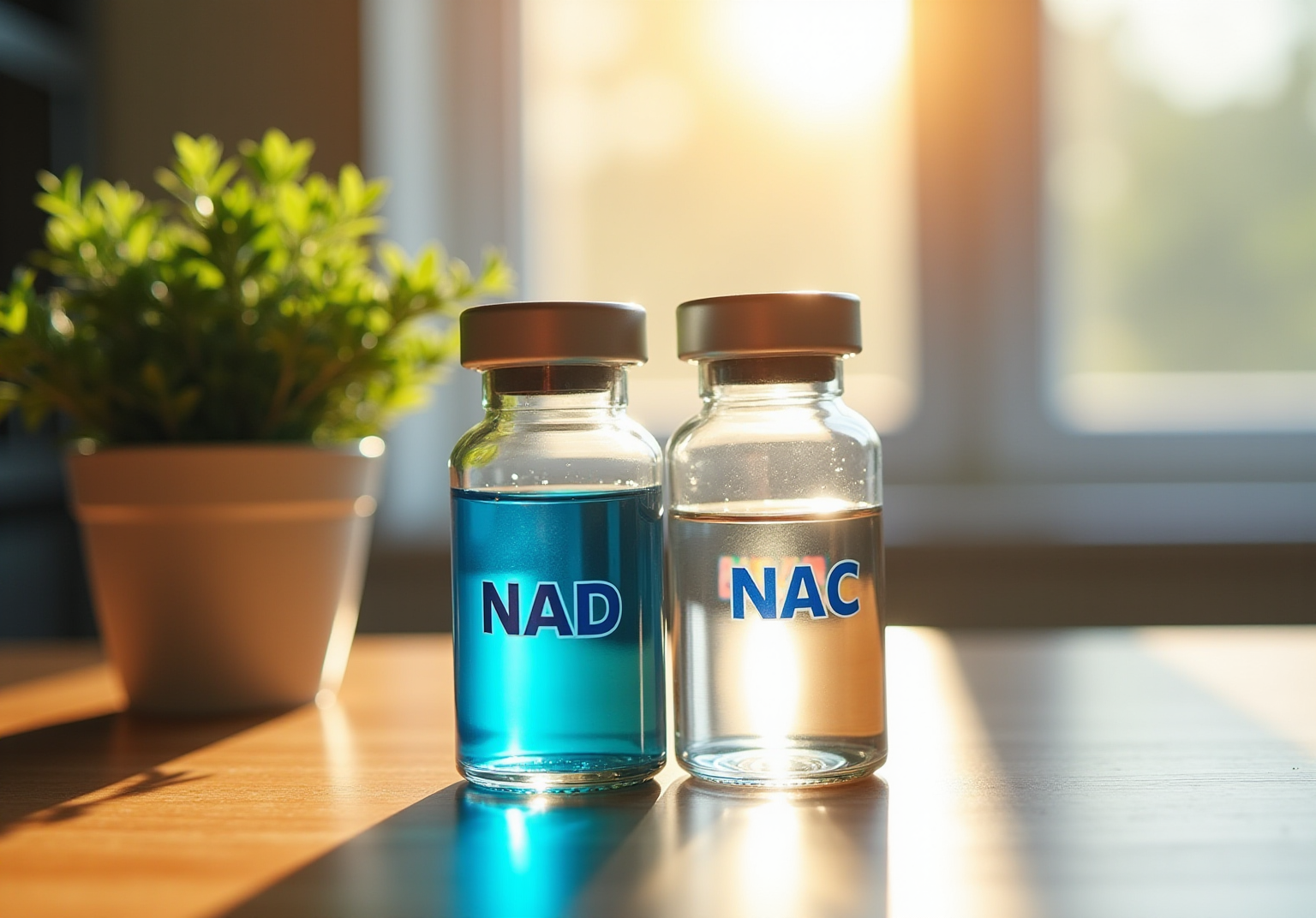NAD vs NAC: Comparing Health Benefits and Mechanisms of Action
Overview
This article explores the health benefits and mechanisms of action of NAD (nicotinamide adenine dinucleotide) and NAC (N-acetylcysteine). NAD is essential for energy metabolism and DNA repair, while NAC acts as a powerful antioxidant that supports detoxification. Understanding these distinctions is crucial.
NAD enhances mitochondrial function and cognitive well-being, making it vital for energy production and cellular health. In contrast, NAC boosts glutathione levels, helping to combat oxidative stress and inflammation. Together, they illustrate complementary roles in promoting overall health.
Considering the benefits of both NAD and NAC, it becomes clear that incorporating these compounds into your health regimen can be advantageous. Explore further resources to learn how to optimize your health through these essential nutrients.
Introduction
In the quest for optimal health and longevity, the roles of nicotinamide adenine dinucleotide (NAD) and N-acetylcysteine (NAC) have emerged as pivotal in supporting cellular functions and combating the effects of aging.
- NAD, a crucial coenzyme found in every living cell, is instrumental in energy production and DNA repair.
- In addition, NAC serves as a powerful antioxidant, enhancing the body’s detoxification processes.
As research continues to unveil the distinct yet complementary benefits of these compounds, individuals are increasingly turning to them as part of their wellness strategies. Understanding how NAD and NAC function, their health benefits, and safety considerations can empower people to make informed choices in their pursuit of vitality and overall well-being.
Define NAD and NAC: Key Characteristics and Functions
Nicotinamide adenine dinucleotide (NAD) is an essential coenzyme found in all living cells. It plays a vital role in energy production, DNA repair, and cellular signaling. NAD exists in two forms: NAD+ (oxidized) and NADH (reduced), which facilitate redox reactions crucial for metabolic processes. Specifically, NAD+ is instrumental in transforming nutrients into energy while also engaging in the repair of damaged DNA, thereby promoting vitality and longevity. This makes NAD a key player in anti-aging strategies, as maintaining its levels can support healthier aging and longevity.
Conversely, N-acetylcysteine (NAC) is a derivative of the amino acid cysteine, primarily recognized as a precursor to glutathione, one of the body’s most powerful antioxidants. NAC is celebrated for its ability to replenish glutathione levels, enhancing the body’s antioxidant defenses and supporting detoxification processes. This antioxidant property is particularly significant, as NAC inhibits the activation of NF-κB, a key transcription factor in the inflammatory response, thereby reducing the release of pro-inflammatory cytokines. Such anti-inflammatory effects position NAC as an advantageous substance in addressing inflammation-related issues, which is essential for overall well-being.
The comparison of NAD vs NAC shows that both are crucial for preserving cellular health. The comparison of NAD vs NAC shows that NAD is vital for energy metabolism and DNA repair, while NAC bolsters antioxidant defenses and detoxification. As research progresses, understanding the unique yet supportive functions of these compounds can empower individuals to make informed decisions about their health and wellness strategies. Personal experiences shared by users on ByKomi.com highlight the positive impacts of incorporating these supplements into their daily routines, emphasizing their roles in promoting longevity and vitality. As Shilpa Amin, M.D., observes, “others are adjustable, indicating that individuals can make specific lifestyle decisions to assist in preventing some issues and encouraging well-being as they age.” Furthermore, more robust studies are needed to confirm NAC’s efficacy and safety in various gastrointestinal conditions. Notably, NAC is commonly available as an over-the-counter nutritional supplement in the United States, Canada, and Australia, making it accessible for health-conscious individuals.
Compare Health Benefits: NAD vs NAC
NAD supplementation offers numerous advantages, such as improved energy levels, enhanced metabolic function, and potential anti-aging effects. Research shows that increasing NAD+ levels significantly supports mitochondrial function, boosts muscle recovery, and enhances cognitive well-being. In contrast, NAC is well-known for its powerful antioxidant properties, which help alleviate oxidative stress and inflammation. This makes NAC particularly beneficial for liver function, respiratory issues, and mental well-being support.
The comparison of NAD vs NAC reveals that while NAD primarily targets energy production and cell repair, NAC focuses on detoxification and antioxidant defense. Together, they form a complementary approach to health and wellness, providing a holistic strategy for those looking to optimize their vitality.
Have you considered the combined benefits of NAD vs NAC? By incorporating both supplements into your routine, you may experience a more comprehensive enhancement of your overall health. Explore further resources to learn how these supplements can support your wellness journey.
Examine Mechanisms of Action: How NAD and NAC Work
NAD operates primarily as a coenzyme in redox reactions, playing a crucial role in metabolic pathways essential for ATP production, DNA repair, and cellular signaling. As individuals age, NAD+ levels naturally decline, which can hinder these critical processes. In contrast, NAC serves as a precursor to glutathione, a powerful antioxidant that strengthens the body’s defenses against oxidative stress. By donating cysteine, NAC enhances glutathione production, thereby increasing the resilience of cells against damage from free radicals and environmental toxins.
Research indicates that NAD is utilized during glycolysis, generating NADH, which is subsequently transferred to the mitochondrial matrix, underscoring its significance in energy production. Furthermore, the therapeutic possibilities of NAD-boosting approaches are currently being explored in relation to aging, emphasizing its role in enhancing tissue well-being.
NAC’s mechanisms extend beyond antioxidant support; it has been demonstrated to significantly enhance glutathione levels, which are crucial for detoxification processes. Clinical studies have shown that NAC can effectively reduce oxidative stress, with evidence suggesting its efficacy in supporting substance use cessation. This dual action of NAD vs NAC not only supports cellular well-being but also emphasizes their complementary roles in combating the aging process and boosting overall vitality.
Assess Safety and Side Effects: Considerations for Use
When comparing NAD vs NAC, both are generally regarded as safe when taken within recommended dosages. However, it is important to note that when comparing NAD vs NAC supplementation, it can lead to mild side effects, including flushing, nausea, and headaches, particularly at higher doses. To gauge individual tolerance, starting with lower doses is advisable. On the other hand, when discussing NAD vs NAC, it is noted that NAC is typically well-tolerated, although some users may experience gastrointestinal issues such as nausea and diarrhea. While NAC boasts a well-established safety profile, excessive intake can result in adverse effects.
Significantly, individuals with prior medical conditions, especially those impacting the liver or kidneys, should consult with healthcare experts before starting either supplement, particularly when considering NAD vs NAC. Recent studies indicate that while NAC supplements may improve dopamine function and alleviate symptoms like tremors in Parkinson’s disease, it remains crucial to tailor supplementation to individual health needs, particularly for those with liver or kidney issues. Furthermore, ongoing research highlights the necessity for larger clinical trials to confirm the cardiovascular benefits of NAD vs NAC supplementation and to evaluate its efficacy in individuals with impaired physiological function.
Lastly, the present study assessed the influence of chronic NR supplementation on healthy middle-aged and older adults, which may have reduced the likelihood of observing greater improvements in physiological function.
Conclusion
The exploration of nicotinamide adenine dinucleotide (NAD) and N-acetylcysteine (NAC) reveals their significant roles in promoting health and longevity. NAD serves as a crucial coenzyme in energy production, DNA repair, and cellular signaling, making it essential for maintaining cellular health and combating the effects of aging. In contrast, NAC acts primarily as a powerful antioxidant and detoxifying agent, enhancing the body’s defenses against oxidative stress and inflammation. Together, these compounds offer a complementary approach to wellness, addressing both energy metabolism and antioxidant support.
Furthermore, the mechanisms through which NAD and NAC operate further underline their importance. NAD’s involvement in metabolic pathways is critical for ATP production and cellular repair, while NAC’s ability to boost glutathione levels fortifies the body’s antioxidant capacity. Both supplements have established safety profiles when used appropriately; however, individuals must consider personal health conditions and consult healthcare professionals before starting supplementation.
In summary, incorporating NAD and NAC into health strategies can be a proactive measure towards improving vitality and promoting healthy aging. As research continues to shed light on their benefits, individuals are encouraged to make informed choices about their health, harnessing the unique properties of these compounds to enhance their overall well-being. By understanding and utilizing NAD and NAC effectively, a holistic approach to health can be achieved, paving the way for a more vibrant and resilient future.
Frequently Asked Questions
What is NAD and what are its key functions?
Nicotinamide adenine dinucleotide (NAD) is an essential coenzyme found in all living cells. It plays a vital role in energy production, DNA repair, and cellular signaling. NAD exists in two forms: NAD+ (oxidized) and NADH (reduced), which facilitate redox reactions crucial for metabolic processes.
How does NAD contribute to anti-aging strategies?
NAD is instrumental in transforming nutrients into energy and repairing damaged DNA, promoting vitality and longevity. Maintaining NAD levels can support healthier aging and is considered a key player in anti-aging strategies.
What is NAC and what are its primary benefits?
N-acetylcysteine (NAC) is a derivative of the amino acid cysteine and is primarily recognized as a precursor to glutathione, a powerful antioxidant. NAC enhances the body’s antioxidant defenses, supports detoxification processes, and inhibits the activation of NF-κB, reducing inflammation.
How do NAD and NAC compare in terms of their functions?
NAD is vital for energy metabolism and DNA repair, while NAC bolsters antioxidant defenses and detoxification. Both are crucial for preserving cellular health but serve different roles in the body.
What personal experiences have been shared regarding the use of NAD and NAC supplements?
Users on ByKomi.com have shared positive impacts from incorporating these supplements into their daily routines, highlighting their roles in promoting longevity and vitality.
Is NAC readily available for consumers?
Yes, NAC is commonly available as an over-the-counter nutritional supplement in the United States, Canada, and Australia, making it accessible for health-conscious individuals.
What further research is needed regarding NAC?
More robust studies are needed to confirm NAC’s efficacy and safety in various gastrointestinal conditions.






